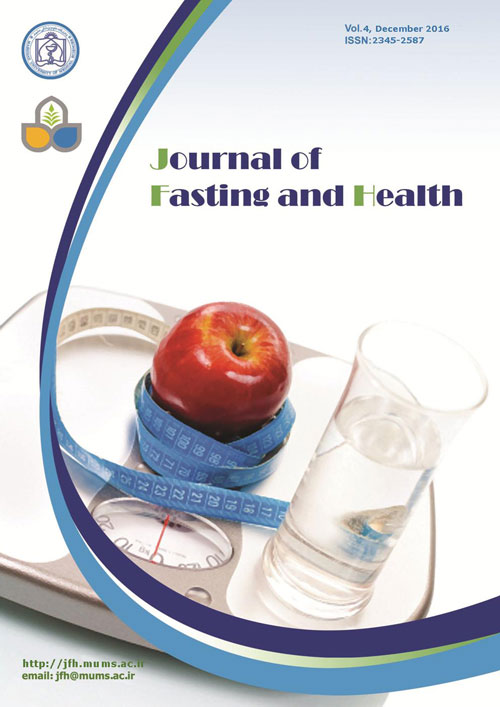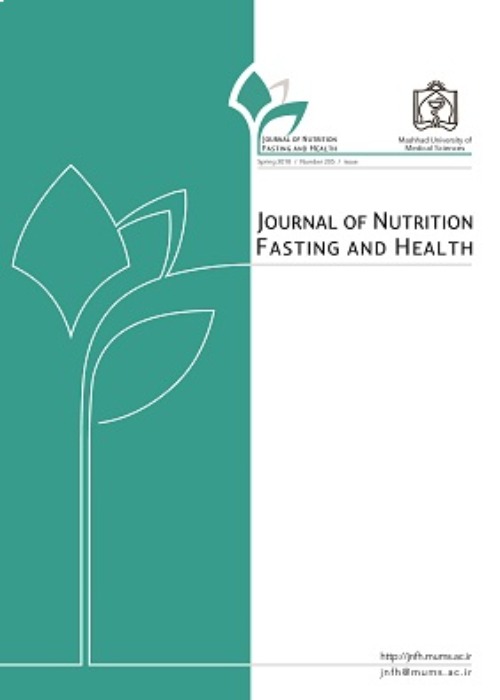فهرست مطالب

Journal of Nutrition, Fasting and Health
Volume:4 Issue: 4, Autumn 2016
- تاریخ انتشار: 1395/10/07
- تعداد عناوین: 8
-
-
Pages 122-123Ramadan is a sacred month for Muslims all around the world. During this lunar-based month, healthy adult Muslims are obligated to abstain from eating, drinking, smoking, or using oral medications from predawn to sunset. Followers will typically eat just after sunset and again before dawn (1). The Islamic lunar Hijri calendar is 11 days shorter than the Gregorian solar calendar, and therefore, the month of Ramadan can occur in any season of the year. The hours spent on fasting can vary from 12 to 18 h, depending on the seasonal and regional features, and this ultimately will affect the ability of individuals and patients to fast. In the North Pole, the day time is very long and may reach up to 22 hours; toward the equator the temperature and humidity are high. These entire environmental factors directly decrease the ability of patients to complete one month of continuous fasting. The studies focusing the impact of fasting during Ramadan on different liver diseases are scarce (2,3) and that is why no structured guidelines for fasting and liver diseases(4) have been set up.Keywords: chronic liver disease, Ramadan fasting, congestive index
-
Pages 124-129IntroductionThis study aimed to investigate the diurnal intraocular pressure fluctuations under dehydration conditions and the relationship between the intraocular pressure fluctuations and blood pressure.MethodsThe intraocular pressures (IOP), body weights, as well as systolic and diastolic blood pressures (SBP, DBP) of 36 fasting healthy volunteers were recorded at 8:00 a.m. and 5:00 p.m. in the Ramadan of 2014 and two weeks after it. The data were analyzed using paired Students t-test and Pearson correlation analysis.ResultsAs the results demonstrated, the mean diurnal IOP differences of IOP, SBP, DBP, and weight were 2.67±1.33 mmHg, 9.44±8.02 mmHg, 3.33±5.94 mmHg, and 0.90±0.46 kg during the fasting period, respectively. In addition, the mean diurnal IOP differences of IOP, SBP, DBP, and weight were -0.33±1.4 mmHg (P=0.001), 0.55±7.25mmHg (P=0.003), -3.33±5.94 mmHg (P=0.001), and 0.12±0.45 kg (P=0.001) during the control period, respectively. There was a moderate correlation between the diurnal IOP and SBP differences (r=0.517, P=0.028).ConclusionBased on the findings of the current study, the total fluid volume might have a more dominant effect on IOP peaks than the sympathetic system activity. Furthermore, the SBP was found to correlate with the IOP.Keywords: autonomic nerve system, intraocular pressure peaks, diurnal intraocular pressure, dehydration
-
Pages 130-135Fasting during the month of Ramadan is one of the Five Pillars of Islam. During this holy month, healthy Muslims abstain from eating, drinking, and smoking from dawn to dusk. Although fasting is obligatory for every adult Muslim, if it has hazardous effects on the body, it is prohibited. Due to some Islamic principles, patients are exempted from fasting; however, due to the willingness of some individuals to fast, there are concerns about its effects on urea, uric acid, and creatine levels. Atypical levels of these compounds can cause serious disorders or indicate abnormal renal function. The present narrative review is aimed to investigate the effect of abnormally high levels of urea, uric acid, and creatinine on ones health and effects of fasting during Ramadan on these indicators. Articles were searched from PubMed, Elsevier and Google Scholar and then they were evaluated. It can be concluded that fasting does not have any adverse effects on the urea, uric acid, and creatinine levels according to the above-mentioned studies.Keywords: Ramadan, Fasting, Urea, Uric acid, Creatinine
-
Pages 136-139IntroductionDuring Ramadan, adult Muslims abstain from drinking and eating from sunrise to sunset. This religious practice influences individuals lifestyle factors such as eating behavior, meal schedule, and sleep pattern. These changes may affect endocrine and neuroendocrine circadian patterns, and consequently, cardiovascular indices. This study was performed to investigate the effects of Ramadan fasting on serum high-sensitivity C-reactive protein (Hs-CRP) and homocysteine as the risk factors for cardiovascular disease and body composition in the Iranian population.MethodsHealthy volunteers who fasted at least during 20 days of Ramadan were included in the study. Body composition and biochemical markers were measured pre- and post-Ramadan fasting. For normally distributed parameters, paired samples t-test was performed for analyzing the differences between the results, and Wilcoxon Signed Ranks test was run for non-normally distributed parameters. All the data was analyzed by SPSS, version 11.5.ResultsFifty-one healthy participants with the mean age of 36±10 years were enrolled in this study. Our analyses showed a reduction in body mass index (BMI) and fat mass pre- and post-Ramadan fasting. However, lean body mass and total body water remained unchanged by fasting. Variation in the serum Hs-CRP and homocysteine were not statistically significant. The results were the same across genders.ConclusionOur study demonstrated that Ramadan fasting may lower fat mass in fasting volunteers with no adverse effects on inflammatory biomarkers of cardiovascular disease.Keywords: Body composition, Fasting, Homocysteine, Hs, CRP, Ramadan
-
Effects of Ramadan fasting on cardiovascular risk factors: A narrative review (ahead of publication)Pages 141-145Ramadan is considered a holy month in the Islamic calendar. During this month, all able-bodied Muslim adults refrain from foods, drinks, smoking, and medications from dawn until sunset. In Islamic rules, patients and those for whom fasting may have major health risks are exempted from fasting during Ramadan. There is still no consensus regarding the effects of Ramadan fasting, as a unique opportunity for lifestyle modifications, on cardiovascular risk factors in the Muslim population. The aim of this scientific literature review was to gather comprehensive results with regard to the effects of Ramadan fasting on major cardiovascular risk factors. This literature review focused on the effects of Ramadan fasting on four main factors, including body weight, blood glucose level, blood pressure, and plasma lipoproteins. According to the results, fasting during Ramadan has positive effects on cardiovascular risk factors. However, limitations of the conducted studies should be considered in specific populations while interpreting the results.Keywords: Ramadan fasting, Body weight, Blood glucose, Blood pressure, Lipoproteins
-
Pages 146-150BackgroundRamadan fasting is an obligation for many Muslims around the world who abstain from eating and drinking for one month, which has different medical and physiological effects, such as reducing blood pressure, lipid profile, blood glucose, and body weight. It has also been hypothesized that Ramadan fasting may induce some changes in the hematologic parameters. Thus, we aimed to investigate the effect of Ramadan fasting on blood cell count (CBC), and erythrocyte sedimentation rate (ESR).MethodsIn the present study, 59 adult healthy individuals, who had completed one month of Ramadan fasting were included. Fasting blood samples were analyzed for ESR, hemoglobin (Hb), hematocrit (Hct), white blood cell (WBC), platelet count (PLT), mean corpuscular Volume (MCV) and mean platelet volume (MPV), one day before, on the second and last week of Ramadan and one month after Ramadan (phase I , II, III, and IV, respectively).Results34 men and 25 women with an age range of 15 to 24 years participated in the study. Mean ESR increased significantly (except phase IV, in comparison phase III). Mean Hb and Hct levels were significantly greater in phase III than phase I (PConclusionRamadan fasting has statistically significant effects on hematological parameters, which were within normal range.Keywords: Fasting, Blood Cell Count, Erythrocyte Sedimentation Rate
-
Pages 151-155ObjectiveTo find out the effect of physical activities and obesity among Ramadan fasting hypertensive patients of Karachi.Methods117 hypertensive patients were selected conveniently from the staff and faculty members of Dow University and other locations of Karachi. The inclusion criterion was the hypertensive patients with at least 20 days of fasting. The investigators visited three times (last ten days of Shaban, Ramadan and Shawwal) for collection of data. A questionnaire was completed before clinical examination. Blood pressures were measured 3 times in sitting position. 103 patients fasted at least 20 days.ResultsThe mean age of the 103 patients was 53.7±11.0 years. 11% participants could be considered as active using MET value of 600 and above. Mean sleeping hours decreased from 6.9 hours in Shaban to 6.3 hours in Ramadan. Mean systolic and diastolic blood pressures decreased from Shaban to Ramadan and bounced back in Shawwal for both active and inactive patients. However, it was statistically significant for inactive patients only. Only mean SBP decreased significantly from Shaban to Ramadan for normal and overweight patients. Combined effect of physical activity, obesity, sleeping pattern and number of fasting days with repeated measure ANOVA showed that only number of fasting days was statistically significant.ConclusionsThe study concludes that fasting does not harm anyway to the hypertensive patients. Nevertheless, it significantly reduces the systolic and diastolic blood pressures. Changes in physical activities, sleeping patterns, and weight reduction, except number days of fasting, do not affect on the fasting hypertensive patients.Keywords: Systolic, diastolic blood pressure, hypertensive patients, Ramadan fasting, Karachi, Pakistan
-
Pages 156-160IntroductionRamadan is a time when Muslims are expected to be calm and peaceful in daily life both mentally and physiologically. Some people believe that they should try to dont have be involved in bad and deviant behaviors in Ramadan. As increasing social safety and reducing crime in society are the most important concerns of the authorities , psychologists, sociologists and governments, they are try to find ways to increase the social safety and decrease the crime rates. The aim of this study was to investigate the statisticaltraumas Due to fights and rate of deviant behaviors during Ramadan compared to Non-Ramadan months of the years 2001 to 2008 in public hospitals in the city of Kermanshah, Iran.MethodOur study was a prospective study. It included patients who were involved in four types of traumas including beating, gunshot, falling from height and car-accident during Ramadan and the Non-Ramadan months of the years 2001 to 2008 admitted to the Emergency Trauma Center Departments (ETCDs) of Taleghani and Imam Reza Hospitals in Kermanshah, Iran.ResultsThe study included 168753 patients. 155705 patients (442.34 mean ± 436.77 SD) were admitted in Non-Ramadan months and the remaining 13048 patients (407.75 mean ± 427.16 SD) in Ramadan month. Based on the results, the average of trauma instances in Non-Ramadan months was higher, but no statistically significant difference was noted between the two groups. We did not observe significant differences for types of traumatic events in Ramadan compared to Non-Ramadan months, but for Non Ramadan months all types of traumatic except gunshot and beating were significant.ConclusionAlthough Ramadan is not a special controlling factor for trauma admissions, but it can has an important effect on the reduction of numbers and types of fight-related trauma admissions in ETCD of hospitals.Keywords: Fight, Trauma, Ramadan month


